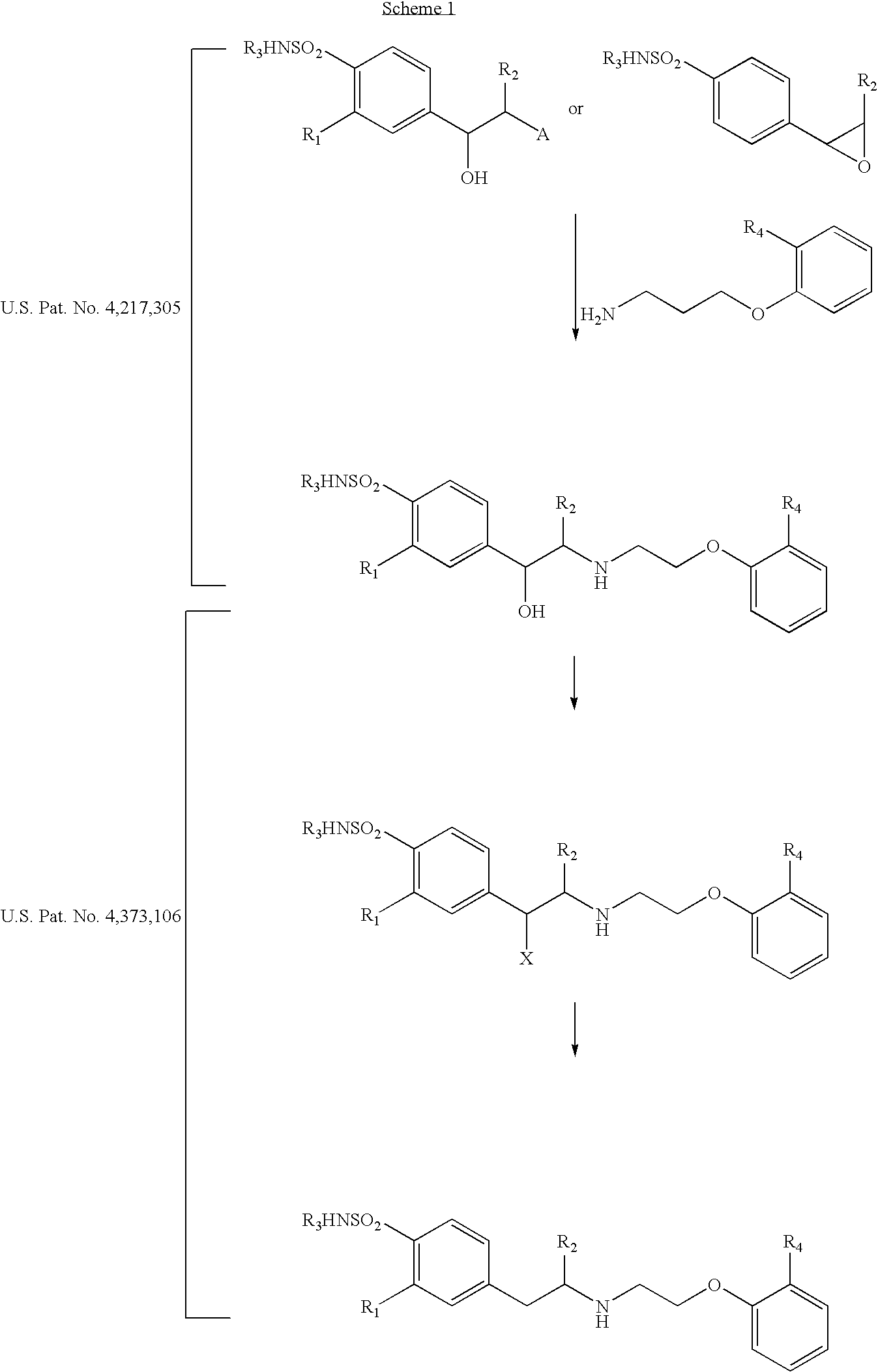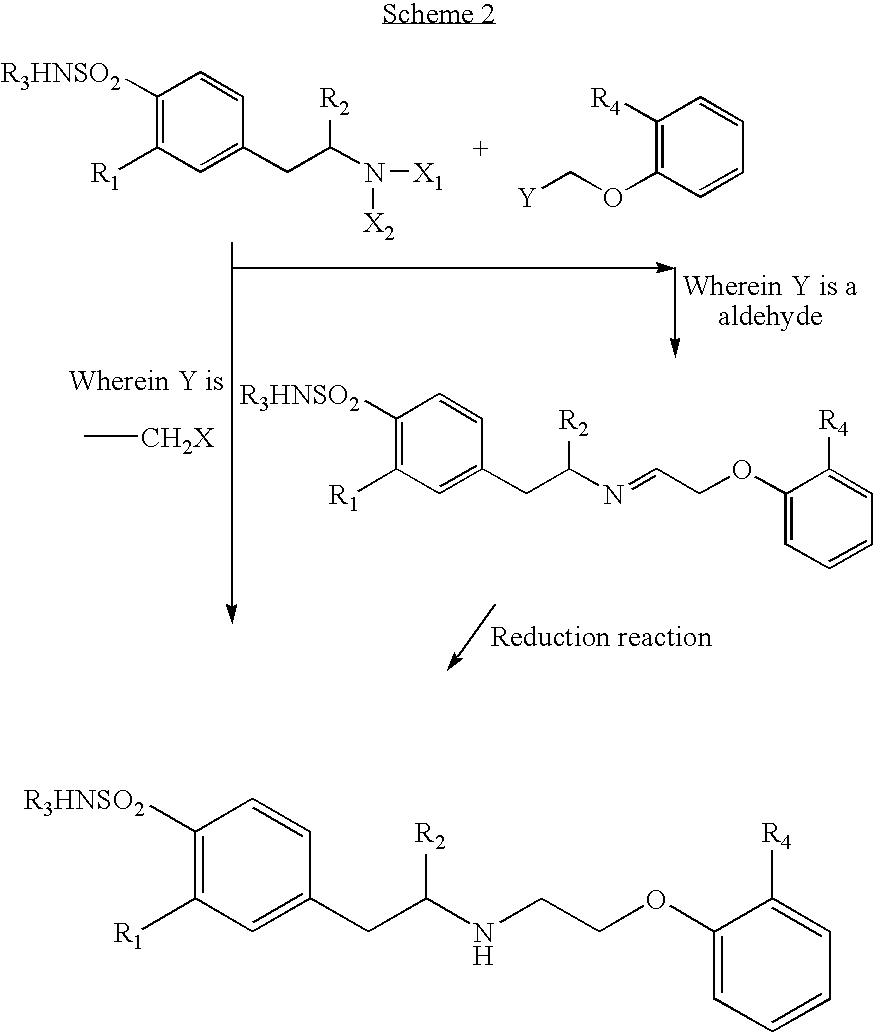Method of preparing optically pure phenethylamine derivatives
a technology of phenethylamine and derivatives, which is applied in the preparation of amino compounds, organic chemistry, carboxylic acid amides, etc., can solve the problems of low yield and inability to easily isolate single isomeric compounds from obtained compounds, and achieve high efficiency
- Summary
- Abstract
- Description
- Claims
- Application Information
AI Technical Summary
Benefits of technology
Problems solved by technology
Method used
Image
Examples
example 1
Preparation of (R)-2-bromo-N-[2-(4-methoxy-3-aminosulfonyl-phenyl)-1-methyl-ethyl]-acetamide)
[0039]1.0 g of (R)-2-(4-methoxyphenyl-3-aminosulfonyl-phenyl)-1-methylethylamine was dissolved in 50 ml of methylene chloride. 0.72 g (2.0 eq) of triethyamine was added to the resultant solution and cooled to 0 to 5° C. Then, 1.44 g (2.0 eq) of bromoacetyl bromide was added dropwise to the resultant solution and stirred at 0 to 5° C. After it was confirmed by HPLC that the starting materials were completely consumed, 100 ml of ethyl acetate and then 50 ml of 10% HCl were added to the resultant solution and stirred. The ethyl acetate layer was separated and washed with 50 ml of a 10% K2CO3 solution and dried over MgSO4, and then, filtered and concentrated. The obtained concentrate was dissolved in ethyl acetate and recrystallized with hexane to obtain the title compound (1.2 g).
[0040]Yield: 80.0% NMR(DMSO-d6):1.15(3H, d), 2.6˜2.8(2H, m), 3.8(2H, s), 3.90(4H, s), 7.0(2H, s), 7.1(1H, d),7.4(1H,...
example 2
Preparation of (R)-2-bromo-N-[2-(4-methoxy-3-aminosulfonyl-phenyl)-1-methyl-ethyl]-acetamide)
[0041]Bromoacetic acid (3.4 g) was dissolved in 50 ml of methylene chloride. 2.3 g of triethyamine was added to the resultant solution and cooled to −40 to −45° C. Then, 2.66 g of ethyl chloroformate was added dropwise to the resultant solution and stirred at −40 to −45° C. for 4 hours. 3.0 g of (R)-2-(4-methoxyphenyl-3-aminosulfonyl-phenyl)-1-methylethylamine was added to the resultant product and stirred at −40 to −45° C. for 1.5 hours. Then, 50 ml of 10% HCl were added to the resultant solution and stirred. The organic layer was separated and washed with 50 ml of 10% K2CO3 solution and dried over MgSO4, and then, filtered and concentrated. The obtained concentrate was dissolved in methanol and recrystallized with hexane to obtain the title compound as a white solid (4.0 g).
[0042]Yield: 89.2% NMR: as described in Example 1 [α]24D=+5.0 (C=1, MeOH)
example 3
Preparation of (R)-2-chloro-N-[2-(4-methoxy-3-aminosulfonyl-phenyl)-1-methyl-ethyl]-acetamide)
[0043]The title compound (1.2 g) was prepared in the same manner as in Example 1, except that 1.05 g (2.0 eq) of chloroacetyl chloride was used instead of bromoacetyl bromide.
[0044]Yield: 92.3% NMR(DMSO-d6): 1.15(3H, d), 2.6˜2.8(2H, m), 3.8(2H, s), 3.90(4H, s), 7.0(2H, s), 7.1(1H, d),7.4(1H, d), 7.6(1H, d), 8.21(2H, d) [α]24D=−2.0 (C=1, MeOH)
PUM
| Property | Measurement | Unit |
|---|---|---|
| reaction temperature | aaaaa | aaaaa |
| reaction temperature | aaaaa | aaaaa |
| temperature | aaaaa | aaaaa |
Abstract
Description
Claims
Application Information
 Login to View More
Login to View More - R&D
- Intellectual Property
- Life Sciences
- Materials
- Tech Scout
- Unparalleled Data Quality
- Higher Quality Content
- 60% Fewer Hallucinations
Browse by: Latest US Patents, China's latest patents, Technical Efficacy Thesaurus, Application Domain, Technology Topic, Popular Technical Reports.
© 2025 PatSnap. All rights reserved.Legal|Privacy policy|Modern Slavery Act Transparency Statement|Sitemap|About US| Contact US: help@patsnap.com



